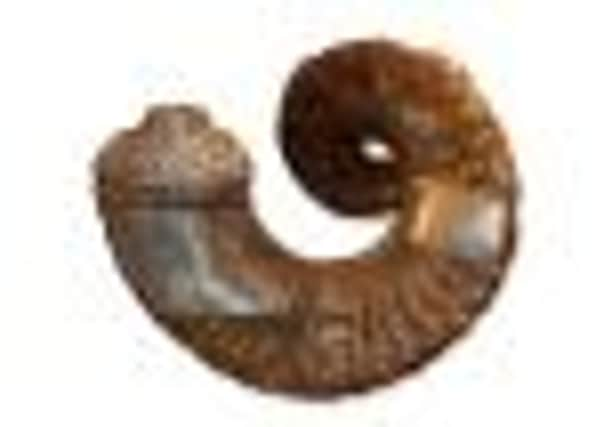Historic shinty trophy found on Highland farm


The decorated ram’s horn will be displayed for the first time in decades when the game is re-enacted this weekend at the same location on Sutherland’s Loth Beach, in Craikaig.
Its whereabouts had been a mystery to the shinty world until its current owner came forward upon hearing about the plans to recreate the match.
Advertisement
Hide AdAdvertisement
Hide AdShinty historian Hugh Dan MacLennan has hailed it as “an amazing discovery”.
The trophy had been presented by players of the original match to notorious landowner, Major William Clunes of Craikaig – who was involved in the Highland Clearances – after he had hosted the game on Old New Year’s Day, 1829.
An inscription on the trophy reads: “From the young men of the parish of Clyne to Major Clunes.
“As a memento of their gratitude for the countenance and encouragement which he, as the only individual supporter from another parish, afforded twenty of their number while engaged in a Shinny Match against an equal number selected from the parishes of Golspie, Rogart, Dornoch and Creich, and which ended in a drawn game, 12th January, 1829.”
Shinny is thought to be the oldest form of the name for the game. The word is still used in Canada and north Minnesota for an informal game of ice hockey played on a frozen pond.
Mary Dudgeon, of Craikaig Farm, has now delighted shinty enthusiasts by coming forward with the trophy.
She said: “It was an amazing coincidence that the trophy returned to the area.
“My father-in-law, William Dudgeon, bought the Craikaig estate in 1922 after being a tenant here since 1908. His father before him had been a tenant since 1863.
Advertisement
Hide AdAdvertisement
Hide Ad“At the same time, in 1922, a cousin found this trophy in an antique shop in Inverness and realised the relevance to Craikaig, so bought it and presented it to my father-in-law. It has been here ever since.
“When I heard about this re-enactment of the original match being played I thought it appropriate to come forward with it.”
She added: “I don’t know why they presented Major Clunes, who was not well liked, with the trophy. I think he gave them a lot of whisky. I believe the game was played all day.”
Hugh Dan MacLennan said the trophy had basically been forgotten about until now.
He said: “I was absolutely gobsmacked when this turned up - it makes you wonder what else is hidden away in people`s lofts? It is an amazing piece of history of the game.
“An amazing and timely discovery.”
Organisers of the re-enacted game on Saturday said: “We will replicate this game in the same location, in the traditional way.
“We invite any and all able bodied player to join with new player, men women, children, novices and total newbies in a communal and community celebration of the ‘Old Ways’.
“It is being organised in the spirit of heritage and community, and it hopes to inspire more engagement with this most ancient of sports.”
Advertisement
Hide AdAdvertisement
Hide AdThe trophy will also be displayed at an event at Timespan Museum in Helmsdale, Sutherland, on 22 March, and a community shinty match in Helmsdale the following day.
The concept of that game is “Incomers versus Locals” and is the culmination of the project by artist-in-residence Anthony Schrag, who recently gave a lecture, About The Clearances for Sheep.
The game aims, in a friendly and fun way, to explore the many connections between Shinty and the Clearances that he has discovered in his research.
He found the tenants of Kildonan, which commemorates the 200th anniversary of The Clearances, actually played a game of shinty in order to spy on the incoming landowners.
It is also assumed that shinty sticks were used during the Kildonan Riots.
Significantly, many of the emigrants to Canada took their traditional ways with them, including their sports games, and there is evidence that the main influence of Canada’s national sport, ice hockey, comes directly from Shinty.
Even today, a casual game played on a frozen pond between friends is still referred to as “Shinny.”
Meanwhile, school pupils already continue a tradition, which dates back to before World War I, of playing shinty on a beach at Farr in north Sutherland.
The match was traditionally held to celebrate a new year.
Advertisement
Hide AdAdvertisement
Hide AdIt could involve up to 100 men, but died out after the end of the war.
Pupils and staff at Farr High School revived the event eight years ago and play it every year on the last school day before the Christmas holidays.